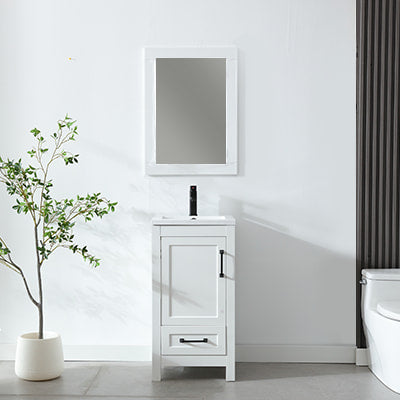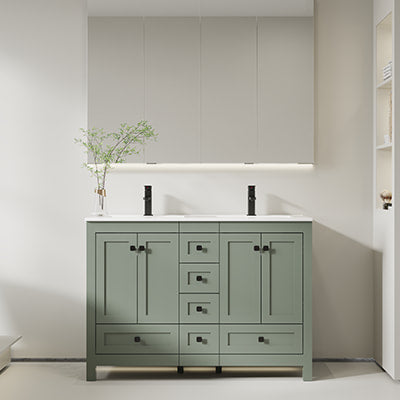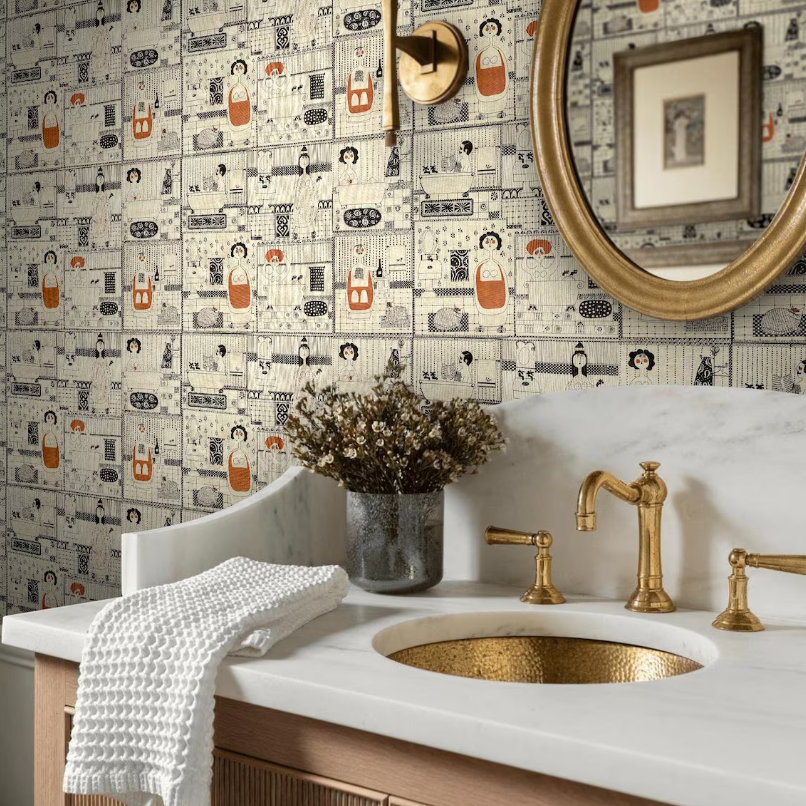Selecting the right bathroom vanity is one of the most critical decisions in bathroom remodeling. Faced with a vast array of products, many homeowners find themselves hesitating between pre-assembled (ready-to-install) and Ready-To-Assemble (RTA) vanities. These two types differ significantly in structure, durability, installation, and price. This article provides a detailed analysis to help you make the best choice for your needs.
I. What is a Pre-assembled Bathroom Vanity?
 Pre-assembled vanities originate from traditional cabinet-making techniques. Their core characteristic is a "one-piece, non-modifiable" structure. They are constructed by meticulously joining panels using screws, fasteners, and adhesives, with no exposed screws at the joints. The finished product cannot be disassembled and reconfigured.
Pre-assembled vanities originate from traditional cabinet-making techniques. Their core characteristic is a "one-piece, non-modifiable" structure. They are constructed by meticulously joining panels using screws, fasteners, and adhesives, with no exposed screws at the joints. The finished product cannot be disassembled and reconfigured.
Key Features:
- Sturdy and Durable: The one-piece monolithic structure offers superior stability, with a typical lifespan exceeding 10 years.
- Fine Craftsmanship: Utilizes high-quality solid wood or multi-layer eco-friendly panels with exquisite detailing and clean, precise edging.
- Ready-to-Use: Medium and small-sized pre-assembled vanities can often be placed directly upon delivery, requiring no on-site assembly.
- Elegant Aesthetics: Often features classic, streamlined designs that enhance the overall bathroom's appeal.
Pre-assembled vanities frequently use environmentally friendly materials, like quality oak, which are non-toxic and ensure safety. Their design balances aesthetics with practicality, offering multiple drawers and open compartments to meet various storage needs.
II. What is a Ready-To-Assemble (RTA) Bathroom Vanity?
 RTA vanities, also known as "flat-pack" or "knock-down vanities," are modular furniture pieces. They rely on modern mass-production technology: panels are batch-processed in factories using CNC routers and then assembled using hardware connectors.
RTA vanities, also known as "flat-pack" or "knock-down vanities," are modular furniture pieces. They rely on modern mass-production technology: panels are batch-processed in factories using CNC routers and then assembled using hardware connectors.
Key Features:
- Easy Transportation: Transported as flat panels, significantly reducing shipping costs.
- Flexible Installation: Can be self-assembled by the user, though it can be time-consuming and requires some skill.
- Budget-Friendly: Efficient mass production typically results in a lower price point than pre-assembled options.
- High Standardization: Feature modular designs, offering some flexibility in internal configuration.
III. Comprehensive Comparison of Core Differences
 1. Structure and Durability
1. Structure and Durability
Pre-assembled vanities boast a one-piece structure with tightly joined panels, minimizing the risk of loosening. Their stability is far superior, capable of withstanding greater weight and frequent use.
RTA vanities depend on connectors for stability. Long-term use may lead to loosening, often requiring maintenance or part replacement within 5-8 years. However, high-quality RTA vanities using new technologies like aluminum honeycomb structures can also achieve moisture resistance, anti-deformation, and impact resistance. For contractors seeking a balance of durability and value, exploring our range of high-quality RTA vanities is a worthwhile option.
2. Installation and Maintenance
Pre-assembled vanities are typically installed by professional teams, saving the homeowner the hassle of assembly. The integral structure simplifies later maintenance, generally requiring only routine cleaning.
RTA vanities require self-assembly or third-party installation, which can be lengthy. Improper installation can affect performance and longevity. A key advantage is the ability to disassemble and reassemble, ideal for renters or those who might move.
3. Price and Value
Pre-assembled vanities generally command a higher price due to labor costs, but they offer guaranteed craftsmanship and durability, providing excellent long-term value.
RTA vanities have a lower upfront cost, suitable for limited budgets or temporary living situations. A decent quality aluminum honeycomb vanity with a ceramic top can cost around a thousand yuan (or equivalent).
4. Suitable Scenarios
Pre-assembled vanities are recommended for long-term use where high demands are placed on aesthetics and stability, especially in primary bathrooms.
RTA vanities are suitable for rentals, budget-conscious projects, temporary use, or small bathrooms.
IV. Additional Considerations When Choosing a Vanity
 Beyond the pre-assembled vs. RTA distinction, consider these factors:
Beyond the pre-assembled vs. RTA distinction, consider these factors:
1.Mounting Style: Freestanding vs. Wall-Mounted
Freestanding Vanities offer ample storage space, ideal for families with high storage needs. However, the base lacks ventilation, can create cleaning dead angle (hard-to-reach areas), and is prone to moisture and mold.
Wall-Mounted Vanities are sleek and space-saving, easy to clean with no dead angle, and resistant to moisture. Installation is more complex, requiring in-wall plumbing (wall-hung toilet configuration), a wall capable of bearing the load, and they offer relatively less storage space.
2. Material Selection
The vanity material directly impacts its lifespan and appearance:
- Solid Wood: Hardwearing and naturally appealing, but generally more expensive and requires attention to moisture protection.
- Ceramic: Excellent waterproofing and easy to clean, but prone to scratching.
- Stainless Steel: Unbeatable water resistance and formaldehyde-free, but designs are often simpler and less aesthetically varied.
- PVC: Smooth, stain-resistant surface with diverse designs, but can soften/deform under heat and has lower load-bearing capacity.
- Aluminum: Zero formaldehyde, resistant to moisture and corrosion, ideal for humid environments.
- Aluminum Honeycomb Structure: Moisture-proof, anti-deformation, impact-resistant, with low water absorption; suitable for families with children/pets.
3. Quality of Hardware
Hinges, slides, and other hardware are the "joints" of the vanity, directly affecting its lifespan. Opt for damped 304 stainless steel hinges for smooth operation and corrosion resistance. Quality hardware ensures long-term reliable use and avoids frequent repairs.
V. How to Choose the Right Vanity for You?
 Decide by considering these factors:
Decide by considering these factors:
- Duration of Use: Prioritize pre-assembled for long-term ownership; consider RTA for short-term or transitional situations.
- Budget: Choose pre-assembled for sufficient budget and quality pursuit; select RTA for limited budgets but pay attention to quality.
- Bathroom Environment: For humid environments, choose materials with good moisture resistance, like aluminum or properly treated wood.
- Storage Needs: Select the appropriate size and internal layout based on the number of toiletries.
- Style Coordination: Consider harmony with the overall bathroom style.
Conclusion
Whether you choose a pre-assembled or an RTA bathroom vanity, the key is to match your actual needs and living situation. Pre-assembled vanities win on stability, durability, and elegant aesthetics, while RTA vanities excel in affordability and transport convenience. We hope this analysis helps you make the smartest choice for your bathroom remodel, creating a practical and comfortable personal space.
Pro Tip: Even the best vanity requires regular care. Lubricate hardware every six months and repair any peeling edge banding immediately to extend its lifespan.
Which type of vanity are you leaning towards? Feel free to share your thoughts and experiences in the comments below.




